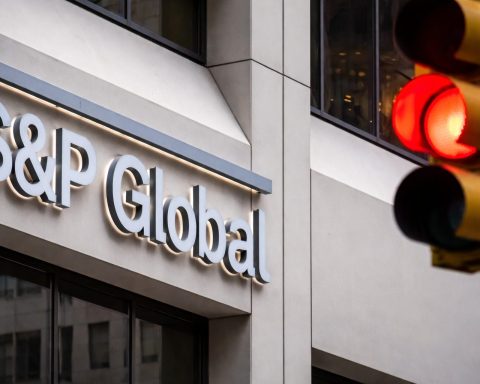- Current Price: HOOD opened near $127.22 on Oct. 23, 2025 [1]. After a crypto-fueled rally, the stock was trading in the low-$120s midday Oct. 23 (the exact close is not yet known).
- Year-to-Date: The stock is still up roughly 250% in 2025 despite a recent pullback [2] [3]. It hit an all-time high around $153 in early October [4].
- S&P 500 Inclusion: Robinhood was added to the S&P 500 in late September, pushing its market cap above $100 billion as index funds were forced to buy [5].
- Revenue & Profit: In Q2 2025, Robinhood reported $989 million revenue (up 45% YoY) and $386 million net income (EPS $0.42) [6], far exceeding forecasts. It now runs at roughly a 50% profit margin.
- Crypto Focus: Robinhood has aggressively expanded its crypto business – it completed a $200 million acquisition of crypto exchange Bitstamp and in Oct. 2025 added Binance’s BNB token to its platform, bringing the total listed tokens to 40+ [7] [8]. In August 2025 Robinhood’s crypto volume was about $8.6 billion [9].
- Analyst Sentiment: Wall Street is largely bullish. JMP Securities raised its price target on HOOD to $170 (Outperform) in mid-October [10]; others like Bank of America ($157) and Morgan Stanley ($146) have lifted targets [11]. The consensus 12-month target is about $119 [12] (implying modest upside). Analysts note the rally is powered by strong earnings and crypto momentum.
- Valuation: The stock trades at a very rich multiple – roughly 60–70× forward earnings [13] (P/E ≈64.6 [14]), far above the broader market. Its price has pushed well above technical supports: the Oct. 21 peak was 253% above its Jan. 1 price, even though the 50-day average is ~$110 [15].
Ride to Record Highs, Then Volatile Pullback
Robinhood’s stock (NASDAQ: HOOD) has had a wild 2025. As of Oct. 23, HOOD is trading in the low-$120s after a steep run. The stock opened on Oct. 23 at $127.22 [16], down from its early-October record high near $153 [17]. Year-to-date, HOOD is up roughly 250% – vastly outperforming broader markets [18] [19]. That meteoric rally coincided with Robinhood’s debut in the S&P 500 at the end of September, a “watershed moment” that forced index funds to buy the stock and pushed its market cap above $100 billion [20].
However, the ascent has been choppy. Volatility spiked in recent weeks as investors took profits. For example, on Oct. 10 HOOD fell about 9% in one day amid a broader tech sell-off [21]. By Oct. 21 it had cooled into the mid-$130s (closing ~$131.84) before slipping again on Oct. 22 [22] [23]. In midday trading on Oct. 23 the stock was roughly 5–7% below its open, dragged lower by a retreat in cryptocurrency prices (Robinhood’s trading volumes are highly correlated with crypto swings). Notably, Reuters reported in April 2025 that Robinhood once “slid as much as 14%” when Bitcoin plunged [24], illustrating how swings in crypto can trigger big moves in HOOD. This pattern continues: on Oct. 23 the pullback in Bitcoin and other digital assets weighed on Robinhood’s shares.
Technically, analysts say a correction was overdue after such a parabolic run. HOOD’s 14-day RSI (Relative Strength Index) had topped 70 (an “overbought” signal) in early October, and the stock was far above key moving averages [25]. “The shares had run well ahead of their moving averages, so a short-term correction isn’t surprising,” notes one strategist [26]. Even after the pullback, HOOD still trades well above its 50-day (~$110) and 200-day (~$79) moving averages [27]. Many traders now watch whether the mid-$130s hold as support or if deeper consolidation will set in.
Recent News and Catalysts
In the days around Oct. 23, Robinhood has made a flurry of news that both excites bulls and adds caution. Key developments include:
- Crypto Expansion (BNB, acquisitions): On Oct. 22 Robinhood added trading support for Binance’s BNB token, making it available to ~27 million funded accounts [28]. The BNB listing came as the token hit new highs (~$1,350) and a market cap near $150 billion [29] [30]. (Coinbase also moved to list BNB, indicating U.S. platforms are warming to Binance-linked assets [31].) Earlier in 2025, Robinhood completed a $200 million acquisition of the Bitstamp crypto exchange, instantly gaining global crypto licenses [32]. These moves have amplified Robinhood’s crypto volumes – the platform saw a 36% month-over-month jump in crypto trading in May 2025, even as Coinbase volumes declined [33] [34]. CEO Vlad Tenev has become a vocal crypto bull, famously saying that “tokenization is going to eat the whole global financial system,” underscoring the company’s ambitions [35].
- Stanford Partnership: On Oct. 20 Robinhood announced a multi-year partnership with Stanford University Athletics to bring its financial education program (“Money Drills”) to student-athletes [36]. Stanford is alma mater to Robinhood’s co-founders, and the deal is seen as a branding win with younger users. Robinhood executive Chloe Barz said this collaboration will “equip our student-athletes with financial tools that will help them thrive” [37].
- Platform Outages: Also on Oct. 20 a major Amazon Web Services (AWS) outage disrupted internet services worldwide. Robinhood’s app (like many fintech sites) experienced interruptions during the AWS downtime [38]. The issue was quickly resolved, but it highlighted the vulnerability of trading platforms to third-party outages. (Robinhood had a separate brief glitch on Oct. 6 as well, which the company is addressing with system upgrades.)
- Regulatory News: After years of scrutiny, the regulatory outlook has brightened. In February 2025 the U.S. SEC quietly closed its investigation into Robinhood’s crypto business with no enforcement action, easing a major overhang [39]. Robinhood had paid a $45 million fine in early 2025 to settle various compliance issues (cybersecurity, recordkeeping, short-selling rules), demonstrating cooperation with regulators [40]. No ban on payment-for-order-flow (the core of Robinhood’s commission-free model) has materialized. Overall, analysts say the SEC’s clemency and clearer crypto guidelines should boost investor confidence.
- Competition: New competitors are emerging. For example, Galaxy Digital launched “GalaxyOne,” a retail trading app aimed at wealthy investors (offering 4% APY on cash) [41]. While GalaxyOne targets a niche market (accredited investors), its entry underscores that Robinhood will face pressure as fintech space grows more crowded.
Analyst Commentary and Stock Forecast
Wall Street analysts have become increasingly upbeat on HOOD, citing its rapid growth and expanding business. In mid-October, JMP Securities’ Devin Ryan raised his price target from $130 to $170 (Maintains “Outperform”) [42]. Ryan noted that fintech stocks have rebounded sharply since spring and that Robinhood’s momentum still offers opportunities despite high multiples [43]. Other banks have similarly lifted targets: Barclays $120, Mizuho $145, Goldman $152, Morgan Stanley $146, and Bank of America $157 [44], reflecting confidence in ongoing user and revenue expansion.
Analysts point to Robinhood’s strong Q2 results (which handily beat forecasts) and continued user growth. MarketBeat notes analysts expect roughly $1.35 EPS for 2025 as a whole [45]. Most firms rate the stock a Buy – indeed MarketBeat reports 12 buys, 7 holds and 1 sell, for a consensus “Moderate Buy” rating [46]. The average 12-month price target is about $118.94 [47], implying a modest upside from current levels.
Still, experts caution the stock’s valuation is rich. Ts2-tech analysts note that HOOD now trades around 60–70× earnings, far above the market average [48]. One strategist told Reuters that the recent rally had pushed shares well past technical norms, so a pause (or correction) was “not surprising” [49]. Indeed, Goldman Sachs analyst James Yaro applauded Robinhood’s new product features (short-selling, social feed) but implicitly acknowledged the risk of running out of momentum. As Yaro put it, the introduction of short-selling required “significant infrastructure enhancements” to enable the feature [50] – a reminder that the stock’s fundamentals must eventually justify its lofty price. One crypto-focused commentator warned that despite the hype, Robinhood’s price “looks expensive” and noted a recent spate of insider selling [51]. However, that same analyst said if Robinhood “delivers on its crypto ambitions, it could become one of the most influential fintech players of the decade.” [52]
Technical and Fundamental Snapshot
On the charts, HOOD is still in bull territory. Its closing price Oct. 22 ($127.22) was well above its 50-day moving average (~$122.43) and nearly 40% above the 200-day average [53], reflecting its strong uptrend. Volume has been heavy as momentum traders join the fray. The stock’s beta is high (~2.4 [54]), meaning it tends to swing much more than the S&P 500. Technical indicators (e.g. RSI) have cooled from overbought levels, suggesting consolidation could continue. Key near-term support is in the mid-$130s (the level of the recent pullback low) – below that, the 50-day SMA (~$122) is the next technical floor.
Fundamentally, Robinhood remains profitable (Q2 net margin ~50% [55]) and growing quickly. It has 26.5 million funded accounts (up 10% YoY) and has seen accelerated paid subscription growth (Robinhood Gold users jumped 76% YoY in Q2) [56]. Its business mix is diversifying: trading revenue is now supplemented by subscription fees, interest from cash accounts, and crypto transaction fees. Robinhood has begun earning interest on customers’ cash (in its new “Robinhood Banking” accounts paying ~4% APY), and even launched a co-branded credit card this year [57]. On the liability side, payment-for-order-flow still funds most of Robinhood’s revenue; this practice remains under SEC scrutiny industry-wide, but no ban has been announced. Overall, Robinhood’s revenue growth (~45% in Q2) and margin profile compare favorably to traditional brokers, justifying its premium to some degree.
What’s Next for HOOD?
Looking ahead, the next big catalyst is the Q3 earnings report expected in early November. Consensus is that Robinhood’s top-line and user growth should remain strong, but investors will watch closely for any signs of slowing crypto demand or margin pressure. Any surprise (good or bad) could send the volatile stock swinging sharply. In the short run, many traders will also be watching Bitcoin (and other crypto prices): a sustained crypto sell-off could weigh on Robinhood, whereas a rebound might lift HOOD again. Strategists note that as long as Robinhood continues to deliver innovation and growth, long-term holders are happy; in the near term, they’re bracing for choppiness.
As one Ts2 market commentator put it, Robinhood’s 2025 story is “remarkable growth tempered by reminders of volatility.” [58] In sum, HOOD has vaulted into fintech’s big leagues – membership in the S&P 500 and institutional backing (BlackRock now owns over 7% of shares [59]) attest to that. But at these heights, any setback (from regulators, crypto markets, or just broad profit-taking) can trigger a sharp pullback. For now, investors will weigh the stock’s strong momentum and transformative strategy against its sky-high valuation and market swings.
Sources: Latest data and analysis from TechStock² (ts2.tech) [60] [61] [62], Reuters [63], MarketBeat [64] [65], and industry reports (TipRanks, FinanceMagnates, CoinCentral, etc.) detailing recent moves and expert commentary.
References
1. www.marketbeat.com, 2. ts2.tech, 3. ts2.tech, 4. ts2.tech, 5. ts2.tech, 6. ts2.tech, 7. ts2.tech, 8. www.financemagnates.com, 9. www.financemagnates.com, 10. ts2.tech, 11. ts2.tech, 12. www.marketbeat.com, 13. ts2.tech, 14. www.marketbeat.com, 15. ts2.tech, 16. www.marketbeat.com, 17. ts2.tech, 18. ts2.tech, 19. ts2.tech, 20. ts2.tech, 21. ts2.tech, 22. ts2.tech, 23. www.marketbeat.com, 24. www.reuters.com, 25. ts2.tech, 26. ts2.tech, 27. ts2.tech, 28. www.financemagnates.com, 29. www.financemagnates.com, 30. www.financemagnates.com, 31. www.financemagnates.com, 32. ts2.tech, 33. ts2.tech, 34. ts2.tech, 35. ts2.tech, 36. ts2.tech, 37. ts2.tech, 38. ts2.tech, 39. ts2.tech, 40. ts2.tech, 41. www.financemagnates.com, 42. ts2.tech, 43. ts2.tech, 44. ts2.tech, 45. www.marketbeat.com, 46. www.marketbeat.com, 47. www.marketbeat.com, 48. ts2.tech, 49. ts2.tech, 50. ts2.tech, 51. coinlaw.io, 52. coinlaw.io, 53. www.marketbeat.com, 54. www.marketbeat.com, 55. ts2.tech, 56. ts2.tech, 57. ts2.tech, 58. ts2.tech, 59. ts2.tech, 60. ts2.tech, 61. ts2.tech, 62. ts2.tech, 63. www.reuters.com, 64. www.marketbeat.com, 65. www.marketbeat.com







